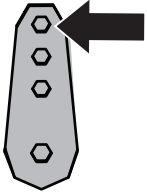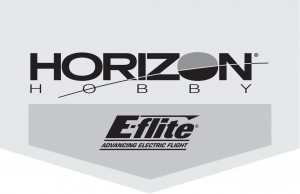
DRACO 2.0m
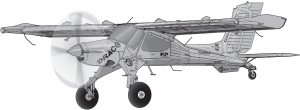
Instruction Manual
![]()
![]()
![]()
![]()
SAFE® Select Technology, Optional Flight Envelope Protection
EN
NOTICE
All instructions, warranties and other collateral documents are subject to change at the sole discretion of Horizon Hobby, LLC. For up-to-date product literature, visit horizonhobby.com or towerhobbies.com and click on the support or resources tab for this product.
MEANING OF SPECIAL LANGUAGE:
The following terms are used throughout the product literature to indicate various levels of potential harm when operating this product:
WARNING: Procedures, which if not properly followed, create the probability of property damage, collateral damage, and serious injury OR create a high probability of superficial injury.CAUTION: Procedures, which if not properly followed, create the probability of physical property damage AND a possibility of serious injury.NOTICE: Procedures, which if not properly followed, create a possibility of physical property damage AND little or no possibility of injury.
![]() WARNING: Read the ENTIRE instruction manual to become familiar with the features of the product before operating. Failure to operate the product correctly can result in damage to the product, personal property and cause serious injury.
WARNING: Read the ENTIRE instruction manual to become familiar with the features of the product before operating. Failure to operate the product correctly can result in damage to the product, personal property and cause serious injury.
This is a sophisticated hobby product. It must be operated with caution and common sense and requires some basic mechanical ability. Failure to operate this Product in a safe and responsible manner could result in injury or damage to the product or other property. This product is not intended for use by children without direct adult supervision. Do not use with incompatible components or alter this product in any way outside of the instructions provided by Horizon Hobby, LLC. This manual contains instructions for safety, operation and maintenance. It is essential to read and follow all the instructions and warnings in the manual, prior to assembly, setup or use, in order to operate correctly and avoid damage or serious injury.
14+ AGE RECOMMENDATION: Not for children under 14 years. This is not a toy.
Safety Precautions and Warnings
As the user of this product, you are solely responsible for operating in a manner that does not endanger yourself and others or result in damage to the product or the property of others.
- Always keep a safe distance in all directions around your model to avoid collisions or injury. This model is controlled by a radio signal subject to interference from many sources outside your control. Interference can cause momentary loss of control.
- Always operate your model in open spaces away from full-size vehicles, traffic and people.
- Always carefully follow the directions and warnings for this and any optional support equipment (chargers, rechargeable battery packs, etc.).
- Always keep all chemicals, small parts and anything electrical out of the reach of children.
- Always avoid water exposure to all equipment not specifically designed and protected for this purpose. Moisture causes damage to electronics.
- Never place any portion of the model in your mouth as it could cause serious injury or even death.
- Never operate your model with low transmitter batteries.
- Always keep aircraft in sight and under control.
- Always use fully charged batteries.
- Always keep transmitter powered on while aircraft is powered.
- Always remove batteries before disassembly.
- Always keep moving parts clean.
- Always keep parts dry.
- Always let parts cool after use before touching.
- Always remove batteries after use.
- Always ensure fail safe is properly set before flying.
- Never operate aircraft with damaged wiring.
- Never touch moving parts.
![]()
![]()
![]()
2 DRACO 2.0m
EN
Box Contents
|
Quick Start Information |
||
| Transmitter
Setup |
1. Blank (Acro) Model | |
| 2. Servo Reversing: Set all to normal | ||
| 3. Travel Adjust (All Surfaces): 100% | ||
| Dual Rates* |
High Rate |
Low Rate |
| Aileron |
|
= 30mm
= 20mm |
| Elevator |
|
= 20mm
= 20mm |
| Rudder |
|
= 30mm
= 30mm |
| Flaps |
Full |
Half |
| Exponential |
High Rate |
Low Rate |
| Aileron | 10% | 5% |
| Elevator | 10% | 5% |
| Rudder | 10% | 5% |
| Center of
Gravity (CG) |
100mm +/- 5mm back from leading edge of wing
slat. |
|
| Flight Timer
Setting |
5 minutes |


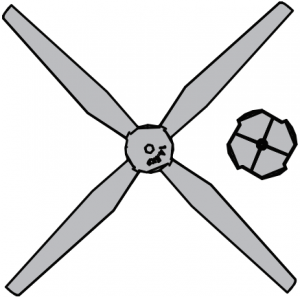




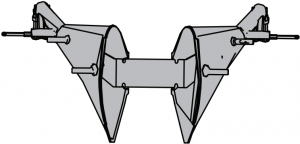




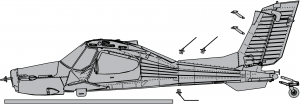

Specifications |
||
| Motor: 5065 Brushless Outrunner: 12
Pole (EFLM5065D) |
Included |
Included |
| ESC: Smart 100-Amp ESC (SPMXAE1100) |
Included |
Included |
| Servos: |
Included |
Included |
| Aileron: A332 9g Sub-Micro MG Servo: 170mm Lead (2) | ||
| Rudder:A332 9g Sub-Micro MG Servo: 170mm Lead (2) | ||
| Elevator: A332 9g Sub-Micro MG Servo: 170mm Lead (2) | ||
| Flaps: A332 9g Sub-Micro MG Servo: 170 Lead (2) | ||
| Receiver: Spektrum™ AR637TA 6-Channel AS3X/SAFE Telemetry Receiver (SPMAR637T) |
Included |
Required to Complete |
| Recommended Battery: 22.2V 5000mAh 6S 30C Smart LiPo Battery: IC5 (SPMX50006S30) |
RequiredtoComplete |
Required to Complete |
| Recommended Battery Charger: S1100 Spektrum Smart AC Charger 1x100W (SPMXC1080) |
RequiredtoComplete |
Required to Complete |
| Recommended Transmitter: Full-Range 2.4GHz 6+ Channel with Spektrum™ DSM2®/ DSMX® technology with programmable mixing and adjustable dual rates |
RequiredtoComplete |
Required to Complete |
|
RECEIVER BIND INFORMATION |
|
| Channels |
6 |
| Frequency |
2404 – 2476 MHz |
| Compatibility |
DSM2 and DSMX |




Table of Contents
Preflight ……………………………………. 4Transmitter Setup …………………………….. 4Binding ……………………………………… 5Model Assembly ……………………………….. 6PNP Receiver Selection and Installation …………. 10Battery Installation and ESC Arming …………….. 11Control Surface Centering and Adjusting a Ball Link . 12Control Horn and Servo Arm Settings …………….. 12SAFE® Select Switch Designation ………………… 13Smart Technology Telemetry …………………….. 13Control Direction Test…………………………. 14AS3X Control Response Test …………………….. 15Center of Gravity (CG) ………………………… 15In-Flight Trimming…………………………….. 15Flying Tips and Repairs ……………………….. 16SAFE® Select Flying Tips……………………….. 16Post Flight ………………………………….. 17Motor Service ………………………………… 17Servo Service ………………………………… 18Troubleshooting Guide AS3X …………………….. 18Troubleshooting Guide …………………………. 19Replacement Parts……………………………… 20AMA National Model Aircraft Safety Code………….. 20Recommended Parts……………………………… 20Optional Parts ……………………………….. 20Limited Warranty ……………………………… 21Contact Information …………………………… 21FCC Information……………………………….. 22IC Information ……………………………….. 22Compliance Information for the European Union…….. 22
If you own this product, you may be required to register with the FAA. For up-to-date information on how to register with the FAA, please visit https://registermyuas.faa.gov/. For additional assistance on regulations and guidance on UAS usage, visit knowbeforeyoufly.org/.
3
EN
Preflight
- Remove and inspect contents.
- Read this instruction manual thoroughly.
- Charge the flight battery.
- Setup Transmitter using transmitter setup chart.
- Fully assemble the airplane.
- Install the flight battery in the aircraft (once it has been fully charged).
- Check the Center of Gravity (CG).
- Bind the aircraft to your transmitter.
- Make sure linkages move freely.
- Perform the Control Direction Test with the transmitter.
- Perform the AS3X Control Direction Test with the aircraft.
- Adjust flight controls and transmitter.
- Perform a radio system Range Test.
- Find a safe open area to fly.
- Plan flight for flying field conditions.
Transmitter Setup
IMPORTANT: After you set up your model, always rebind the transmitter and receiver to set the desired failsafe positions.
The BNF Basic version of this model has a built in aileron to rudder mix, when the ailerons are deflected the rudder will move.
IMPORTANT: The included receiver has been programmed specifically for operation in this aircraft.
If your transmitter allows it, enable the throttle cut feature. Always engage throttle cut before approaching the aircraft.
Dual Rates
Low rate is recommended for the initial flights.
NOTICE: To ensure AS3X® technology functions properly, do not lower rate values below 50%. If lower rates are desired, manually adjust the position of the pushrods on the servo arm.
NOTICE: If oscillation occurs at high speed, refer to the Troubleshooting Guide for more information.
Exponential
After first flights, you may adjust expo in your transmitter.
Transmitter Telemetry Setup
If the transmitter that you intend to use with this aircraft is not displaying telemetry data, visit Spektrumrc.com and update your firmware. With the latest firmware installed on your transmitter the telemetry option should now be functional on your transmitter.
Some of the terminology and function locations used in the iX12 and iX20programming may be slightly different than other Spektrum AirWare™ radios. The names given in parentheses correspond to the iX12 and iX20 programming terminology. Consult your transmitter manual for specific information about programming your transmitter.
The settings provided above for the DX6 and DX6e do not allow for the use of a SAFE Select switch. To use a SAFE Select switch on these systems see the section below for transmitter setup and operation information.
|
Computerized Transmitter Setup |
||
| Start all transmitter programming with a blank ACRO model (perform a model reset), then name the model. | ||
| Set Dual Ratesto | 2 Position switch | 3 Position switch |
| HIGH 100% | HIGH 100% | |
| MID 70% | ||
| LOW 50% | LOW 50% | |
| Set Servo Travelto | 100% | |
| Set Throttle Cutto | -100% | |
| DXe | Refer to spektrumrc.com for the appropriate
download setup. |
|
| DX7S DX8 | 1. Go to the SYSTEM SETUP | |
| 2. Set MODEL TYPE: AIRPLANE | ||
| 3. Set WING TYPE: 1 AIL 1 FLAP | ||
| 4. Go to CHANNEL ASSIGN:
CHANNEL INPUT CONFIG AUX2 Switch A SELECT GEAR: INH |
||
| 5. Go to the FUNCTION LIST | ||
| 6. Go to Digital Switch Setup:
Switch: Switch A Pos 0: -100 Pos 1: -100 no motor reversing OR Pos 1: 100 motor reversing |
||
| 7. Set FLAP SYSTEM: Choose Flap
NORM: -100% FLAP 0% Elevator MID: -20% FLAP 10% Elevator LAND: 9% FLAP 16% Elevator SPEED 2.0S: SWITCH = FLAP |
||
| DX6e DX6 (Gen2) DX7 (Gen2) DX8e DX8 (Gen2) DX9 DX10t DX18 DX20 iX12 iX20 NX6 NX8 NX10 | 1. Go to the SYSTEM SETUP (Model Utilities)† | |
| 2. Set MODEL TYPE: AIRPLANE | ||
| 3. Set AIRCRAFT TYPE (Model Setup, Aircraft
Type)†: WING: 1 AIL 1 FLAP |
||
| 4. Go to CHANNEL ASSIGN:
CHANNEL INPUT CONFIG AUX2 Switch A Not available on DX6 or DX6e transmitters |
||
| 5. Go to the FUNCTION LIST (Model Adjust)† | ||
| 6. Go to Digital Switch Setup:
Switch: Switch A Pos 0: -100 Pos 1: -100 no motor reversing OR Pos 1: 100 motor reversing Not available on DX6 or DX6e transmitters |
||
| 7. Set FLAP SYSTEM:
SELECT SWITCH D: POS 0: -100% FLAP* 0% Elevator POS 1: -20% FLAP* 10% Elevator POS 2: 9% FLAP* 16% Elevator SPEED 2.0 |
4 DRACO 2.0m
EN
Binding
General Binding Tips
- The included receiver has been specifically programmed for operation of this aircraft. Refer to the receiver manual for correct setup if the receiver is replaced.
- Keep away from large metal objects while binding.
- Do not point the transmitter’s antenna directly at the receiver while binding.
- The orange LED on the receiver will flash rapidly when the receiver enters bind mode.
- Once bound, the receiver will retain its bind settings for that transmitter until you re-bind.
- If the receiver loses transmitter communication, the failsafe will activate. Failsafe moves the throttle channel to low throttle. Pitch and roll channels move to actively level the aircraft in flight.
- If problems occur, refer to the troubleshooting guide or if needed, contact the appropriate Horizon Product Support office.
General Binding Tips
The BNF Basic version of this airplane includes SAFE Select technology, enabling you to choose the level of flight protection. SAFE mode includes angle limits and automatic self leveling. AS3X mode provides the pilot with a direct response to the control sticks. SAFE Select is enabled or disabled during the bind process.
With SAFE Select disabled the aircraft is always in AS3X mode. With SAFE Select enabled the aircraft will be in SAFE Select mode all the time, or you can assign a switch to toggle between SAFE Select and AS3X modes.
Thanks to SAFE Select technology, this aircraft can be configured for full-time SAFE mode, full-time AS3X mode, or mode selection can be assigned to a switch.
IMPORTANT: Before binding, read the transmitter setup section in this manual and complete the transmitter setup table to ensure your transmitter is properly programmed for this aircraft.
IMPORTANT: Move the transmitter flight controls (rudder, elevators, and ailerons) and the throttle trim to neutral. Move the throttle to low before and during binding.
You can use either the bind button on the receiver case or the conventional bind plug to complete the binding and SAFE Select process.
When using the auxiliary BEC from an ESC installed in the bind port of the receiver, unplug it to use bind plug.
A bind plug extension has been provided in BNF models. It will be labeled and located in the battery compartment for easy access.
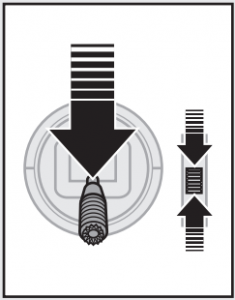



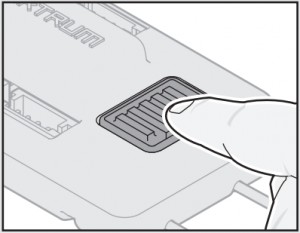

Lower Throttle Connect Power Press and hold Bind Button
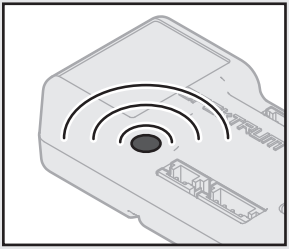

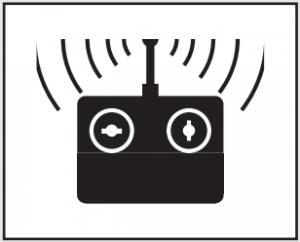


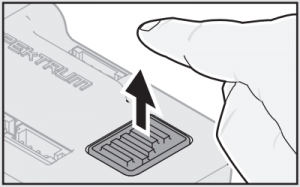

Orange Flashing LED Bind TX to RX Release Bind Button
SAFE Select Enabled: The control surfaces cycle back and forth twice with a slight pause at neutral position every time the receiver is powered on.
Using Bind PlugSAFE Select Enabled
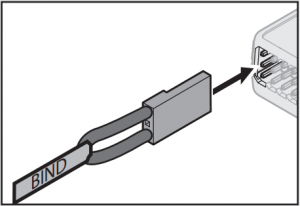





Install Bind Plug Lower Throttle Connect Power


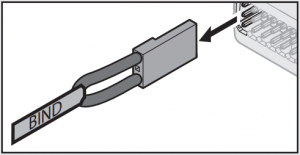



Orange Flashing LED Remove Bind Plug Bind TX to RX
SAFE Select Enabled: The control surfaces cycle back and forth twice with a slight pause at neutral position every time the receiver is powered on.
SAFE Select Disabled






Lower Throttle Connect Power Press Bind Button






Orange Flashing LED Release Bind Button Bind TX to RX
SAFE Select Disabled: The control surfaces cycle back and forth once every time the receiver is powered on.
SAFE Select Disabled






Install Bind Plug Lower Throttle Connect Power







Orange Flashing LED Bind TX to RX Remove Bind Plug
SAFE Select Disabled: The control surfaces cycle back and forth once every time the receiver is powered on.
*FailsafeIf the receiver loses transmitter communication, the failsafe will activate. When activated, failsafe moves the throttle channel to its preset failsafe position (low throttle) that was set during binding. All other channels move collectively and actively to place the aircraft in a slow descending turn.
5
EN
Model Assembly
Landing Gear Installation
- Install two 5mm ID washers (A) and one wheel onto each axle of the landing strut.
- Secure the wheels in place with one 3.5mm ID washer (B) and M5 nylon locknuts (C), using a 5mm nut driver.
- Install the landing gear assembly (D) on the fuselage and secure in place using M4 x 20mm screws (E).
- Remove the paper from the double side stick tape and install the foam cover (F) onto the center of the main gear assembly.
Disassemble in reverse order.
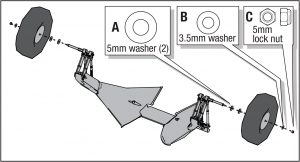
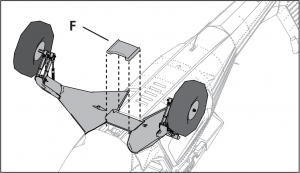
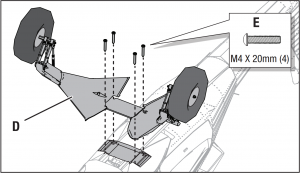
Tail Wheel Installation
- Remove the two screws to remove the two small plastic covers (A) (left and right side).
- Install the tailwheel assembly (B) with two M3 x 20mm screws and M5 nylon locknuts.IMPORTANT: Do not over tighten the 3mm screws and M5 nuts. Over tightening will prevent the tail gear from pivoting up and down.
- Reinstall the small rear plastic covers. (extra set in parts bag are the sameas removed from the aircraft).
- Install the tailwheel springs (C) using needle nose pliers. Attach each springto the tail wheel assembly steering arm first, then attach the other end to the steering arm on the fuselage.
Disassemble in reverse order.


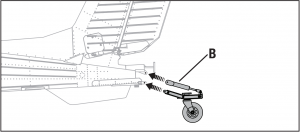

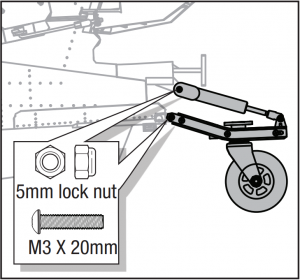

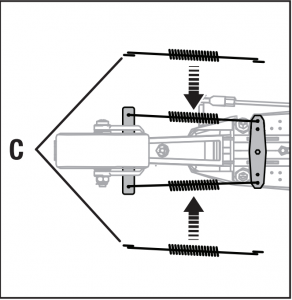

6 DRACO 2.0m
Model Assembly Continued
Horizontal Stabilizer Installation
- Slide the horizontal tail (A) into the slot at the rear of the fuselage until the retaining clip clicks. Ensure the control horn and the two support struts are facing down.
- Snap the left and right support struts (B) onto the ball-links (C).
- Bind your aircraft to the model and power on the aircraft to ensure the elevator servo is centered before adjusting and connecting the elevator linkage.
- Snap the elevator control linkage (D) on the ball-link (E).
- Ensure the elevator and rudder servo arms are in the correct position, then adjust the linkage to center them.
Disassemble in reverse order.
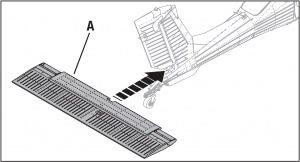



Aileron Counterbalance and Wing Tip Guard Installation
- Carefully press the included wing tip guard (A) into the wing slot until it is fully seated.
- Carefully align the counterbalance (B) and seat it into the recess.
- Secure the counterbalance into place with the included 2.5 x 6mm screw (C).
- Repeat aileron counterbalance and wing tip guard installation for the opposite wing.
Disassemble in reverse order.
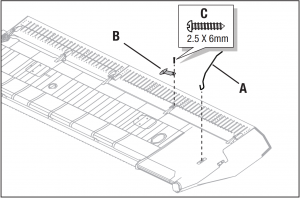

Handle Installation
- Carefully apply medium CA to the handle. Use only one or two drops to prevent CA glue from running.
- Carefully press the handle (A) into the recess in the wing until the handle is fully seated.
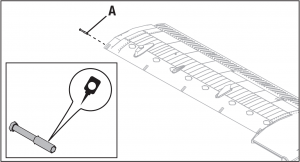

7
EN
Model Assembly Continued
Leading Edge Slat Installation
- Carefully apply medium CA to each slat pocket. Use only one or two drops and hold the wing to prevent CA glue from running.
- Mount the slat onto the wing with the rounded edge facing forward. Also ensure the slates are installed with the Horizon Hobby Logo near the wing root.
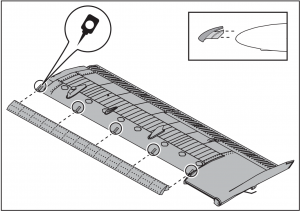

Wing Installation
- Slide the wing tube (A) into the fuselage.
- Install the right and left wing (B and C) onto the wing tube and into the wing pocket of the fuselage.
- Secure the left and right wings to the fuselage using the four included nylon locking pins (D). Turn the pin 90 degrees to lock in place.
Disassemble in reverse order.
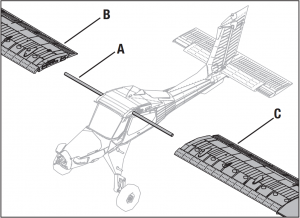

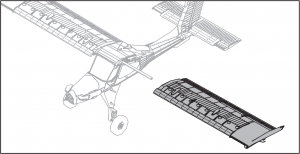

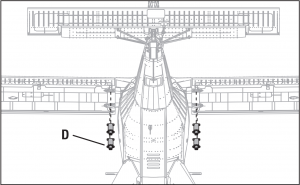

8 DRACO 2.0m
EN
Model Assembly Continued
Foot Step Installation
- Press the right and left foot steps (A) into the slots in the fuselage with the tab facing to the front of the aircraft.
- Secure the right and left foot steps into place with 3 x 8mm self tapping screws (B).Disassemble in reverse order.
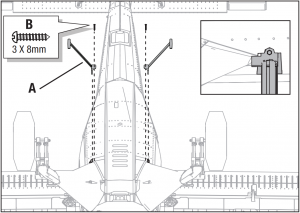

Antenna Installation
- Apply medium CA to the base of the belly antenna (A) and press it into the slot on the bottom of the fuselage.
- Apply medium CA to the base of the top fuselage antenna (B) and press it into the respective slot in the top of the fuselage.
- Apply medium CA to the base of the wing antenna (C) and press it into the respective slot in the right wing.
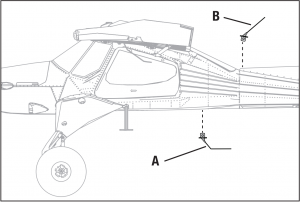

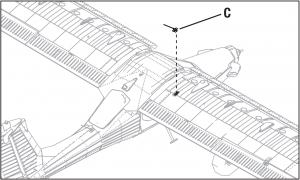

Propeller Installation
- Remove spinner nut and washer from propeller shaft.
- Slide the propeller (A), and washer (B) onto the motor shaft (C).
- Install and tighten the spinner nut (D) using an adjustable wrench (13mm).
- Slide the spinner (E) onto the shaft in front of the propeller.
- Secure the spinner with the spinner screw M3 x 10mm (F).
Disassemble in reverse order.
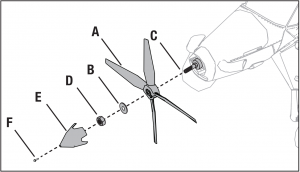

9
EN
Model Assembly Continued
LED Light Controller Settings and Options
- Plug the light controller into the gear channel (Port 5).
- Assign the gear (port 5) to the rotary knob of your transmitter to give full control of all 7 light modes.
If your transmitter doesn’t have a rotary knob option, the light module can still function and be assigned to any 2 or 3 position switch, however not all light modes will be available. Travel adjust and sub trim can be used to change modes for the 2 or 3 position switch.
The light module can also be Y-harnessed with any channel like flaps but you will only get the light groups in the position the channel is in.
|
Lights |
|
| Mode 1 | Instrument panel light in the fuselage (Always ON when Light Module is connected) |
| Mode 2 | Red and green navigation lights, wingtip strobes and lights onthe trailing edge of rudder |
| Mode 3 | Mode 2 with the addition of flashing light on top of rudder. |
| Mode 4 | Mode 3 with the addition of wingtip landing lights and 45ºwing light |
| Mode 5 | Mode 4 with the addition of nose flashing light and 90º downflashing wing light |
| Mode 6 | Mode 5 with the addition of backup light. |
| Mode 7 | All flashing lights OFF (Flashing nose light and 90º downflashing wing light |
PNP Receiver Selection and Installation
The recommended receiver for this aircraft is the Spektrum AR637T. If you choose to install a different receiver, ensure that it is at least a 6-channel full range receiver. Refer to the manual of your chosen receiver for correct installation and operation instructions.
AR637T Installation
- Remove the rear window of the aircraft by pulling up on the side tabs.
- Remove the receiver hatch by pulling up on the hatch tabs, to expose the receiver compartment.
- Connect the appropriate control surfaces to the their respective ports on the receiver using the table at the right.
- Using double-sided servo tape (not included) mount the receiver to the flat area of the receiver compartment, as shown. The receiver (A) should be mounted in the orientation shown, parallel to the length of the fuselage, with the label facing up and the servo ports facing the rear of the aircraft. The orientation of the receiver is critical for all AS3X® and SAFE® technology setups.
![]()
![]()
![]()
![]()
![]()
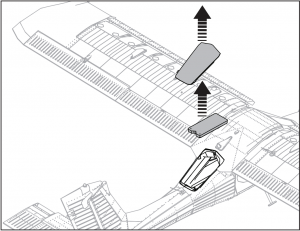

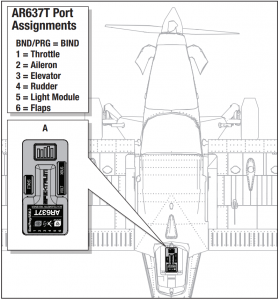

10 DRACO 2.0m
EN
Battery Installation and ESC Arming
Battery Selection
We recommend a 5000mAh 22.2V 6S 30C Li-Po battery (SPMX50006S30). Refer to the Optional Parts List for other recommended batteries. If using a battery other than those listed, the battery should be within the range of capacity, dimensions and weight of the Spektrum Smart Li-Po battery packs to fit in the fuselage. Be sure the model balances at the recommended CG.
- Lower the throttle to the lowest setting. Power on the transmitter, then wait 5 seconds.
- For added security apply the loop side (soft side) of the optional hook and loop tape (A) to the bottom of your battery and the hook side to the battery tray.
- Install the fully charged battery (B) in the battery compartment as shown. See the Adjusting the Center of Gravity instructions for more information.
- Make sure the flight battery is secured using the hook and loop straps (C).
- Connect the battery to the ESC.
- Keep the aircraft immobile on its landing gear and away from wind or the system will not initialize.· An LED will light on the receiver.· The ESC will sound single tones until the receiver and transmitter connect. Once connected, the ESC will sound the cell count and then a double ascending tone. The ESC is now armed.If the ESC sounds a continuous beep after the flight battery is connected, recharge or replace the battery.
- Reinstall the canopy hatch.
![]()
![]()
![]()
![]()
![]()
![]()
![]()
![]()
![]()
![]()
- 6S 5000mAh in the middle of the battery tray.
- 4S 5000mAh all the way forward on the battery tray.
- 6S 7000mAh all the way rearward on the battery tray.
Adjust the placement of the battery as needed to achieve proper CG.![]()
![]()
![]()
![]()
![]()
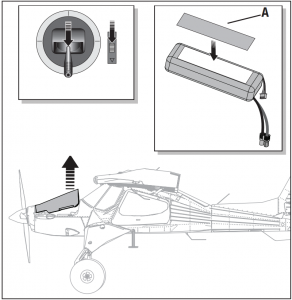

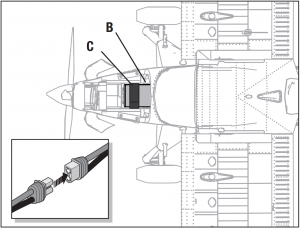

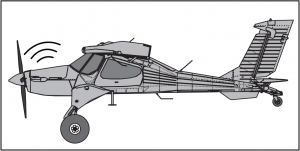

11
EN
Control Surface Centering and Adjusting a Ball Link
IMPORTANT: Perform the Control Direction Test before performing control surface centering.
While SAFE is inactive, mechanically center the control surfaces.
IMPORTANT: Correct operation of the SAFE system requires sub-trim and trim at 0.
After binding a transmitter to the receiver, set the trims and sub-trims to 0, ensure the servo arms are in the correct positions, then adjust the linkages to center the control surfaces.




- Turn the linkage clockwise or counterclockwise until the control surface is centered.
- Attach the linkage to the servo arm or control horn after adjustment
Control Horn and Servo Arm Settings
The table to the right shows the factory settings for the control horns and servo arms. Fly the aircraft at factory settings before making changes.
NOTICE: If control throws are changed from the factory settings, the AR637T gain values may need to be adjusted. Refer to the Spektrum AR637T manual for adjustment of gain values.
After flying, you may choose to adjust the linkage positions for the desired control response. See the table to the right.
|
Horns |
Arms |
|
| Elevator |    |
|
| Ailerons |   |
|
| Rudder |    |
  |
| Flaps | 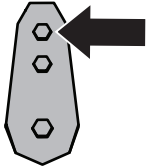  |
More control throw Less control throw
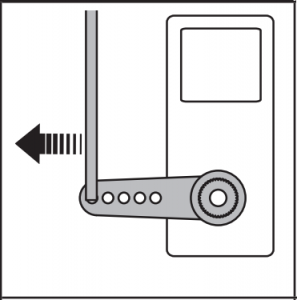

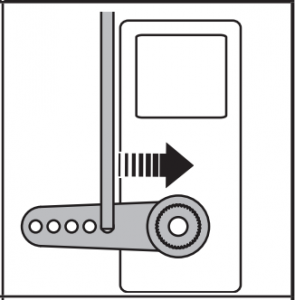

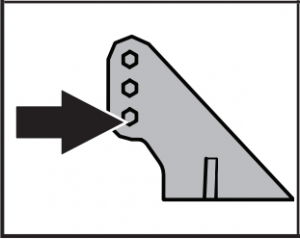



12 DRACO 2.0m
EN
SAFE® Select Switch Designation
Once SAFE Select is enabled, you can choose to fly in SAFE mode full-time, or assign a switch. Any switch on any channel between 5 and 9 can be used on your transmitter.
TIP: If model has a reversing ESC feature, Aux 2 is not available for safe select.
If the aircraft is bound with SAFE Select disabled, the aircraft will be in AS3X mode exclusively.
![]()
![]()
![]()
![]()
![]()
![]()
IMPORTANT: To be able to assign a switch, first verify:
- The aircraft was bound with SAFE Select enabled.
- Your choice for the SAFE Select switch is assigned to a channel between 5 and 9 (Gear, Aux1-4), and travel is set at 100% in each direction.
- The aileron, elevator, rudder and throttle direction are set to normal, not reverse.
- The aileron, elevator, rudder and throttle are set to 100% travel. If dual rates are in use, the switches need to be in the 100% position.
See your transmitter manual for more information about assigning a switch to a channel.
TIP: If a SAFE Select switch is desired for your 6-function aircraft, and you are using a 6 channel transmitter, the SAFE Select switch channel will have to be shared with either channel 5 or 6 of the transmitter.
Assigning a Switch
- Power on the transmitter.
- Power on the aircraft.
- Hold both transmitter sticks to the inside bottom corners, and toggle the desired switch 5 times quickly (1 toggle = full up and down).
- The control surfaces of the aircraft will move, indicating the switch has been selected.
Repeat the process to assign a different switch or to deactivate the current switch.
SAFE Select Switch Assignment Stick Positions
Mode 1 and 2 transmitters Assigned Switch
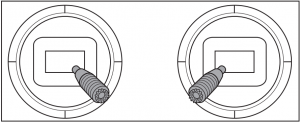

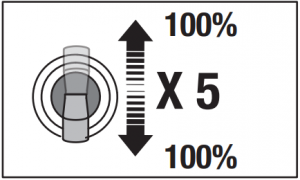

TIP: Use the channel monitor to verify channel movement.
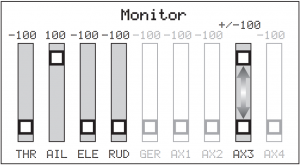

This example of the channel monitor shows the stick positions for assigning a switch, the switch selection on Aux3, and +/- 100% travel on the switch.
Smart Technology Telemetry
This aircraft includes Spektrum Smart Technology in the ESC and receiver, which can provide telemetry information such as battery voltage and ESC temperature. To take advantage of Smart Technology, you will need a compatible transmitter. A firmware update for your transmitter may be required.
To access all the available features of Smart Technology, use Spektrum Smart batteries to power this aircraft. In addition to ESC data, Spektrum Smart batteries can communicate detailed battery data through the Smart Technology system.
To View Smart Telemetry:
- Begin with the transmitter bound to the receiver
- Power on the transmitter.
- Power on the aircraft.
- The Smart Logo appears under the battery logo on the home page. A signal bar appears in the top left corner of the screen.*
- Scroll past the servo monitor to view Smart technology screens.
* If the transmitter that you intend to use with this aircraft is not displaying telemetry data, visit spektrumrc.com and update your firmware. With the latest firmware installed on your transmitter the telemetry option should now be functional on your transmitter.
For more information about compatible transmitters, firmware updates, and how to use the Smart Technology on your transmitter, visit spektrumrc.com.
ESC Status
RPM: 0Volts: 0.0VMotor: 0.0A 0% OutputThrottle: 0%Fet Temp: 0.0CBEC: 0.0C 0.0A 0.0V
13
EN
Control Direction Test
Switch on the transmitter and connect the battery. Use the transmitter to operate the aileron, elevator and rudder controls. View the aircraft from the rear when checking the control directions.
The BNF Basic version of this model has a built in aileron to rudder mix, when the ailerons are deflected the rudder will move.
Elevator
- Pull the elevator stick back. The elevators should move up, which will cause the aircraft to pitch up.
- Push the elevator stick forward. The elevators should move down, which will cause the aircraft to pitch down.
Ailerons
- Move the aileron stick to the left. The left aileron should move up and the right aileron down, which will cause the aircraft to bank left.
- Move the aileron stick to the right. The right aileron should move up and the left aileron down, which will cause the aircraft to bank right.
Rudder
- Move the rudder stick to the left. The rudder should move to the left, which will cause the aircraft to yaw left.
- Move the rudder stick to the right. The rudder should move to the right, which will cause the aircraft to yaw right.
Flaps
- Move your flap control switch down to the “half flaps” position.
- Confirm that the flaps move down.
- Move flap control switch to the full flaps position.
- Confirm the flaps move farther down than in step two.
| Transmitter
Command |
Control Surface
Response |
|
| Elevator | 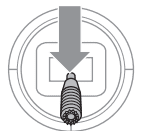  |
  |
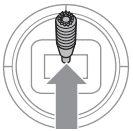  |
  |
|
| Ailerons | 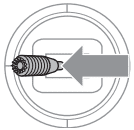   |
  |
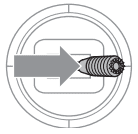   |
  |
|
| Rudder |    |
  |
   |
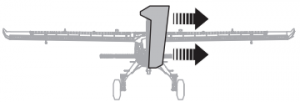  |
|
| Flaps |   |
14 DRACO 2.0m
AS3X Control Response Test
This test ensures that the AS3X® control system is functioning properly. Assemble the aircraft and bind your transmitter to the receiver before performing this test.
1. Raise the throttle just above 25%, then lower the throttle to activate AS3X.![]()
![]()
![]()
![]()
![]()
![]()
Once the AS3X system is active, control surfaces may move rapidly. This is normal. AS3X remains active until the battery is disconnected.
Due to different effects of torque, lift, and drag some aircraft require trim changes with different speeds and throttle settings. Mixes are pre-loaded into the receiver to compensate for these changes. The mixes become active the first time the throttle is raised above 25%. The control surfaces may be offset slightly at different throttle settings after the first time throttle is raised. Trimming the plane in flight should be done at 80-100% throttle for best results.
|
Aircraftmovement |
AS3X Reaction |
|
| Elevator |   |
  |
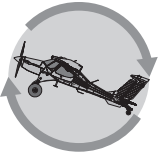  |
  |
|
| Ailerons | 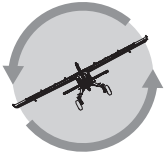  |
|
  |
  |
|
| Rudder | 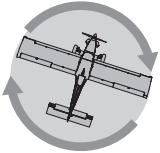  |
  |
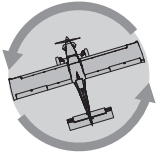  |
  |
Center of Gravity (CG)
The CG location is measured from the leading edge of the wing slat. This CG location has been determined with the recommended Li-Po battery (SPMX50006S30) installed in the center of the battery tray.
![]()
![]()
![]()
![]()
![]()
![]()
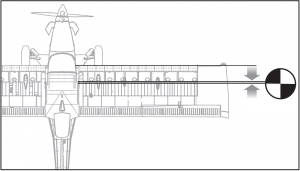

100mm +/- 5mm back from leading edge of wing slat.
In-Flight Trimming
During your first flight, trim the aircraft for level flight at 80-100% throttle. Make small trim adjustments with your transmitter’s trim switches to achieve straight and level flight.
After adjusting trim do not touch the control sticks for 3 seconds. This allows the receiver to learn the correct settings to optimize AS3X performance.
Failure to do so could affect flight performance.
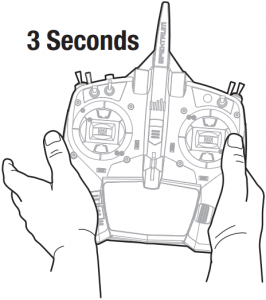

15
EN
Flying Tips and Repairs
Consult local laws and ordinances before choosing a flying location.
Range Check your Radio System
Before you fly, range check the radio system. Refer to your specific transmitter instruction manual for range test information.
Oscillation
Once the AS3X system is active (after advancing the throttle for the first time), you will normally see the control surfaces react to aircraft movement. In some flight conditions you may see oscillation (the aircraft rocks back and forth on one axis due to overcontrol). If oscillation occurs, refer to the Troubleshooting Guide for more information.
Takeoff
Place the aircraft in position for takeoff (facing into the wind). Select low rates for first takeoff and gradually increase the throttle to 3/4 to full and steer with the rudder. Pull back gently on the elevator and climb to a comfortable altitude.
Flying
For your first flights with the recommended battery pack (SPMX50006S30), set your transmitter timer or a stopwatch to 5 minutes. After five minutes, land the aircraft. Adjust your timer for longer or shorter flights once you have flown the model.
Fly the aircraft and trim it for level flight in AS3X Mode at 80-100% throttle. After landing, adjust the linkages mechanically to account for trim changes and then reset the trims to neutral. Ensure the aircraft will fly straight and level with no trim or sub-trim.
Landing
To land the aircraft, fly the aircraft down to the ground using 1/4 1/3 throttle to allow for enough energy for a proper flare. The aircraft is easiest to land doing a wheel landing (two point), where the aircraft touches down on the main landing gear first while the tailwheel is still off the ground. The aircraft can also be landed in a three-point attitude, where all three wheels touch down at the same time. When the aircraft touches down, reduce back pressure on the elevator stick to prevent the plane from becoming airborne again.
If landing on grass, it is best to hold full up elevator after touchdown and when taxiing to prevent nosing over.
Once on the ground, avoid sharp turns until the plane has slowed enough to prevent scraping the wing tips.
![]()
![]()
NOTICE: If a crash is imminent, reduce the throttle and trim fully. Failure to do so could result in extra damage to the airframe, as well as damage to the ESC and motor.
NOTICE: After any impact, always ensure the receiver is secure in the fuselage. If you replace the receiver, install the new receiver in the same orientation as the original receiver or damage may result.
NOTICE: Crash damage is not covered under warranty.
NOTICE: When you are finished flying, never leave the aircraft in direct sunlight or in a hot, enclosed area such as a car. Doing so can damage the aircraft.
Low Voltage Cutoff (LVC)
When a Li-Po battery is discharged below 3V per cell, it will not hold a charge. The ESC protects the flight battery from over-discharge using Low Voltage Cutoff (LVC). Before the battery charge decreases too much, LVC removes power supplied to the motor. Disconnect and remove the Li-Po battery from the aircraft after use to prevent trickle discharge. Charge your Li-Po battery to about half capacity before storage. During storage, make sure the battery charge does not fall below 3V per cell. LVC does not prevent the battery from over-discharge during storage.
NOTICE: Repeated flying to LVC will damage the battery.
Tip: Monitor your aircraft battery’s voltage before and after flying by using a Li-Po Cell Voltage Checker (SPMXBC100, sold separately).
Repairs
Thanks to the EPO foam material in this aircraft, repairs to the foam can be made using virtually any adhesive (hot glue, regular CA, epoxy, etc). When parts are not repairable, see the Replacement Parts List for ordering by item number. For a listing of all replacement and optional parts, refer to the list at the end of this manual.
NOTICE: Use of CA accelerant on your aircraft can damage paint. DO NOT handle the aircraft until accelerant fully dries.
SAFE® Select Flying Tips
When flying in SAFE Select mode the aircraft will return to level flight any time the aileron and elevator controls are at neutral. Applying aileron or elevator control will cause the airplane to bank, climb or dive. The amount the stick is moved will determine the attitude the airplane flies. Holding full control will push the aircraft to the pre-determined bank and roll limits, but it will not go past those angles.
When flying with SAFE Select, it is normal to hold the control stick deflected with moderate aileron input when flying through a turn. To fly smoothly with SAFE Select, avoid making frequent control changes and don’t attempt to correct for minor deviations. Holding deliberate control inputs will command the aircraft to fly at a specific angle, and the model will make all corrections to maintain that flight attitude.
When flying with SAFE Select, throttle will make the aircraft climb or descend. Full throttle will cause the aircraft to pitch up and climb slightly. Mid throttle will keep the airplane flying level. Low throttle will cause the airplane to descend slightly nose-down.
Return the elevator and aileron controls to neutral before switching from SAFE Select mode to AS3X mode. If you do not neutralize controls when switching into AS3X mode, the control inputs used for SAFE Select mode will be excessive for AS3X mode and the aircraft will react immediately.
Differences between SAFE Select and AS3X modes
This section is generally accurate but does not take into account flight speed, battery charge status, and other limiting factors.
| CONTROLInput | SAFE Select | AS3X |
| Control stickis neutralized | Aircraft will self level | Aircraft will continue to fly at its presentattitude |
| Holding asmall amount ofcontrol | Aircraft will bank or pitch to a moderate angle and maintain the attitude | Aircraft will continue to pitch or roll slowly |
| Holding fullcontrol | Aircraft will bank or pitch to the predeterminedlimits and maintain theattitude | Aircraft will continue to roll or pitch rapidly |
| Throttle | Full throttle: ClimbNeutral: Level flightLow throttle: Descend | Throttle will not affect flight response. |
16 DRACO 2.0m
Thrust Reversing (optional)
This aircraft is equipped with the Avian™ 100 Amp Smart ESC with reversing. Reversing the motor can be helpful when taxiing or for shortening ground roll after a landing.
Simply assign a switch to channel 7 (Aux 2) of your transmitter. Flip the switch to reverse the direction of the motor. (The SRXL2 connection of the Smart ESC to the AR637TA receiver allows the ESC to receive combined input from both channel 7 and channel 1 (throttle).
IMPORTANT: The motor will draw more current in reverse as the propeller is less efficient and creates more drag. This can reduce flight time.
IMPORTANT: Thrust reversing requires a Spektrum receiver with Smart Throttle such as the AR637TA and a Spektrum transmitter with a minimum of 7 channels. The Avian ESC is also backwards compatible with receivers that only provide a PWM output.
Post Flight
- Disconnect the flight battery from the ESC (Required for Safety and battery life).
- Power OFF the transmitter.
- Remove the flight battery from the aircraft.
- Recharge the flight battery.
- Repair or replace all damaged parts.
- Store the flight battery apart from the aircraft and monitor the battery charge.
- Make note of the flight conditions and flight plan results, planning for future flights.
Motor Service
![]()
![]()
![]()
![]()
![]()
![]()
Disassembly
- Remove the screw (A), spinner (B), propeller nut (C) and washer (D).
- Remove the propeller (E) from the motor shaft.
- Remove the 4 screws (G) from the motor mount (H), and remove the motorand motor mount from the fuselage.
- Remove the 4 screws (I) from the prop adapter and remove from motor.
- Disconnect the motor wires from the ESC wires.
- Remove the 4 screws (J) and motor (K) from the motor mount.
Assembly
Assemble in reverse order. ·
- Correctly align and connect the motor wire colors with the ESC wires.
- Tighten the prop nut by using a 13mm wrench.
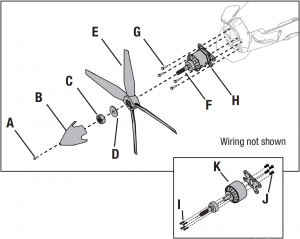

17
EN
Servo Service
|
Control Surface |
Replacement Servo | Description |
Extension Lead Length |
| Aileron | SPMSA332 | 9g Sub-Micro Servo,170mm Lead | 610mm(24 inches) |
| Elevator | SPMSA332 | 9g Sub-Micro Servo,170mm Lead | 460mm(18 inches) |
| Rudder | SPMSA332 | 9g Sub-Micro Servo,170mm Lead | 305mm(12 inches) |
| Flaps | SPMSA332 | 9g Sub-Micro Servo,170mm Lead | 230mm(9 inches) |
IMPORTANT: An extension lead may be required to replace servos in some locations.
Troubleshooting Guide AS3X
|
Problem |
Possible Cause |
Solution |
| Oscillation | Damaged propeller or spinner | Replace propeller or spinner |
| Imbalanced propeller | Balance the propeller. | |
| Motor vibration | Replace parts or correctly align all parts and tighten fasteners as needed | |
| Loose receiver | Align and secure receiver in fuselage | |
| Loose aircraft controls | Tighten or otherwise secure parts (servo, arm, clevis, horn and control surface) | |
| Worn parts | Replace worn parts (especially propeller, spinner or servo) | |
| Irregular servo movement | Replace servo | |
| Inconsistent flight performance | Trim is not at neutral | If you adjust trim more than 8 clicks, adjust the clevis to remove trim |
| Sub-Trim is not at neutral | No Sub-Trim is allowed. Adjust the servo linkage | |
| Aircraft was not kept immobile for 5 seconds after battery connection | With the throttle stick in lowest position. Disconnect battery, then reconnect battery and keep the aircraft still for 5 seconds | |
| Incorrect response to the AS3X Control Direction Test | Incorrect direction settings in the receiver, which can cause a crash | DO NOT fly. Correct the direction settings (refer to the receiver manual), then fly |
18 DRACO 2.0m
EN
Troubleshooting Guide
|
Problem |
Possible Cause |
Solution |
| Aircraft will not respond to throttle but responds to other controls | Throttle not at idle and/or throttle trim too high | Reset controls with throttle stick and throttle trim at lowest setting |
| Throttle servo travel is lower than 100% | Make sure throttle servo travel is 100% or greater | |
| Throttle channel is reversed | Reverse throttle channel on transmitter | |
| Motor disconnected from ESC | Make sure motor is connected to the ESC | |
| Extra propeller noise or extra vibration | Damaged propeller and spinner, collet or motor | Replace damaged parts |
| Propeller is out of balance | Balance or replace propeller | |
| Prop nut is too loose | Tighten the prop nut | |
| Reduced flight time or aircraft underpowered | Flight battery charge is low | Completely recharge flight battery |
| Propeller installed backwards | Install propeller with numbers facing forward | |
| Flight battery damaged | Replace flight battery and follow flight battery instructions | |
| Flight conditions may be too cold | Make sure battery is warm before use | |
| Battery capacity too low for flight conditions | Replace battery or use a larger capacity battery | |
| Aircraft will not Bind (during binding) to transmitter | Transmitter too near aircraft during binding process | Move powered transmitter a few feet from aircraft, disconnect and reconnect flight battery to aircraft |
| Aircraft or transmitter is too close to large metal object, wireless source or another transmitter | Move aircraft and transmitter to another location and attempt binding again | |
| The bind plug is not installed correctly in the bind port | Install bind plug in bind port and bind the aircraft to the transmitter | |
| Flight battery/transmitter battery charge is too low | Replace/recharge batteries | |
| Bind switch or button not held long enough during bind process | Power off transmitter and repeat bind process. Hold transmitter bind button or switch until receiver is bound | |
| Aircraft will not connect (after binding) to transmitter | Transmitter too near aircraft during connecting process | Move powered transmitter a few feet from aircraft, disconnect and reconnect flight battery to aircraft |
| Aircraft or transmitter is too close to large metal object, wireless source or another transmitter | Move aircraft and transmitter to another location and attempt connecting again | |
| Bind plug left installed in bind port | Rebind transmitter to the aircraft and remove the bind plug before cycling power | |
| Aircraft bound to different model memory (ModelMatchTM radios only) | Select correct model memory on transmitter | |
| Flight battery/Transmitter battery charge is too low | Replace/recharge batteries | |
| Transmitter may have been bound to a different aircraft using different DSM protocol. | Bind aircraft to transmitter | |
| Control surface does not move | Control surface, control horn, linkage or servo damage | Replace or repair damaged parts and adjust controls |
| Wire damaged or connections loose | Do a check of wires and connections, connect or replace as needed | |
| Transmitter is not bound correctly or the incorrect airplanes was selected | Re-bind or select correct airplanes in transmitter | |
| Flight battery charge is low | Fully recharge flight battery | |
| BEC (Battery Elimination Circuit) of the ESC is damaged | Replace ESC | |
| Controls reversed | Transmitter settings are reversed | Perform the Control Direction Test and adjust the controls on transmitter appropriately |
| Motor power pulses then motor loses power | ESC uses default soft Low Voltage Cutoff (LVC) | Recharge flight battery or replace battery that is no longer performing |
| Weather conditions might be too cold | Postpone flight until weather is warmer | |
| Battery is old, worn out, or damaged | Replace battery | |
| Battery C rating might be too low | Use recommended battery |
19
EN
Replacement Parts
Part # Description
EFL12551 Painted Fuselage: DRACO 2.0mEFL12552 Painted Right Wing: DRACO 2.0mEFL12553 Painted Left Wing: DRACO 2.0mEFL12554 Painted Stabilizer with Struts: DRACO X 2.0mEFL12555 Painted Cowl: DRACO 2.0mEFL12556 Decal Sheet: DRACO 2.0mEFL12557 Prop Adapter: DRACO 2.0mEFL12558 Servo Covers: DRACO 2.0mEFL12559 Flat Aluminum Landing Gear: DRACO 2.0mEFL12560 Hatch Set: DRACO 2.0mEFL12561 Wheel Set: DRACO 2.0mEFL12562 Landing Gear Axles:DRACO 2.0mEFL12563 Aluminum Landing Gear Arms: DRACO 2.0mEFL12564 Landing Gear Fairings: DRACO 2.0mEFL12565 Motor Mount: DRACO 2.0mEFLP145904B 14.5 x 9 4 Blade Propeller: DRACO 2.0mEFL12567 Spinner: DRACO 2.0mEFLM5065D 5065 Brushless Outrunner Motor : DRACO 2.0mEFLA520D Light Controller: DRACO 2.0mEFL12568 Shocks: DRACO 2.0mEFL12569 Tailwheel Unit: DRACO 2.0mEFL12570 Plastic Detail Set: DRACO 2.0mEFL12571 Carbon Wing Tube: DRACO 2.0mEFL12572 Hardware Set: DRACO 2.0mEFL12573 Pushrod Set: DRACO X 2.0mEFL12574 Wing Screws and Hoops: DRACO 2.0mEFL12576 Pilot: DRACO 2.0mSPMAR637T AR637T 6CH SAFE and AS3X TelemRXSPMSA332 9g Sub-Micro MG Servo: 170mm LeadSPMXAE1100 Avian 100 Amp Brushless Smart ESC, 3S-6SSPMR8105 DX8e 8-Channel Transmitter OnlySPMX50006S30 5000mAh 6S 22.2V Smart 30C; IC5SPMXC1080 Smart S1100 AC Charger, 1x100WSPMXCA508 Adapter: IC3 Battery / IC5 Device
Optional Parts
Part # Description
SPMXBC100 LiPo Cell Voltage CheckerSPM6722 Spektrum Single Aircraft TX CaseSPMA9574 Aircraft Telemetry Airspeed IndicatorSPMA9589 Aircraft Telemetry Altitude and Variometer SensorSPMXC1000 Smart S1200 DC Charger, 1x200WSPMXC10201 30A 540W Power SupplySPMR6775 NX6 6-Channel Transmitter OnlySPMR8200 NX8 8-Channel DSMX Transmitter OnlyAR8360T AR8360T DSMX 8-Channel AS3X & SAFE Telemetry Receiver
AMA National Model Aircraft Safety Code
Academy of Model AeronauticsNational Model Aircraft Safety Code
Effective January 1, 2018
A model aircraft is a non-human-carrying device capable of sustained flight within visual line of sight of the pilot or spotter(s). It may not exceed limitations of this code and is intended exclusively for sport, recreation, education and/or competition. All model flights must be conducted in accordance with this safety code and related AMA guidelines, any additional rules specific to the flying site, as well as all applicable laws and regulations.
As an AMA member I agree:
- I will not fly a model aircraft in a careless or reckless manner.
- I will not interfere with and will yield the right of way to all human carrying aircraft using AMA’s See and Avoid Guidance and a spotter when appropriate.
- I will not operate any model aircraft while I am under the influence of alcohol or any drug that could adversely affect my ability to safely control the model.
- I will avoid flying directly over unprotected people, moving vehicles, and occupied structures.
- I will fly Free Flight (FF) and Control Line (CL) models in compliance with AMA’s safety programming.
- I will maintain visual contact of an RC model aircraft without enhancement other than corrective lenses prescribed to me. When using an advanced flight system, such as an autopilot, or flying First-Person View (FPV), I will comply with AMA’s Advanced Flight System programming.
- I will only fly models weighing more than 55 pounds, including fuel, if certified through AMA’s Large Model Airplane Program.
- I will only fly a turbine-powered model aircraft in compliance with AMA’s Gas Turbine Program.
- I will not fly a powered model outdoors closer than 25 feet to any individual, except for myself or my helper(s) located at the flightline, unless I am taking off and landing, or as otherwise provided in AMA’s Competition Regulation.
- I will use an established safety line to separate all model aircraft operations from spectators and bystanders.
20 DRACO 2.0m
EN
Limited Warranty
What this Warranty Covers – Horizon Hobby, LLC, (Horizon) warrants to the original purchaser that the product purchased (the “Product”) will be free from defects in materials and workmanship at the date of purchase.
What is Not Covered – This warranty is not transferable and does not cover (i) cosmetic damage, (ii) damage due to acts of God, accident, misuse, abuse, negligence, commercial use, or due to improper use, installation, operation or maintenance, (iii) modification of or to any part of the Product, (iv) attempted service by anyone other than a Horizon Hobby authorized service center, (v) Product not purchased from an authorized Horizon dealer, or (vi) Product not compliant with applicable technical regulations, or (vii) use that violates any applicable laws, rules, or regulations.
OTHER THAN THE EXPRESS WARRANTY ABOVE, HORIZON MAKES NO OTHER WARRANTY OR REPRESENTATION, AND HEREBY DISCLAIMS ANY AND ALL IMPLIED WARRANTIES, INCLUDING, WITHOUT LIMITATION, THE IMPLIED WARRANTIES OF NON-INFRINGEMENT, MERCHANTABILITY AND FITNESS FOR A PARTICULAR PURPOSE. THE PURCHASER ACKNOWLEDGES THAT THEY ALONE HAVE DETERMINED THAT THE PRODUCT WILL SUITABLY MEET THE REQUIREMENTS OF THE PURCHASER’S INTENDED USE.
Purchaser’s Remedy – Horizon’s sole obligation and purchaser’s sole and exclusive remedy shall be that Horizon will, at its option, either (i) service, or (ii) replace, any Product determined by Horizon to be defective. Horizon reserves the right to inspect any and all Product(s) involved in a warranty claim. Service or replacement decisions are at the sole discretion of Horizon. Proof of purchase is required for all warranty claims. SERVICE OR REPLACEMENT AS PROVIDED UNDER THIS WARRANTY IS THE PURCHASER’S SOLE AND EXCLUSIVE REMEDY.
Limitation of Liability – HORIZON SHALL NOT BE LIABLE FOR SPECIAL, INDIRECT, INCIDENTAL OR CONSEQUENTIAL DAMAGES, LOSS OF PROFITS OR PRODUCTION OR COMMERCIAL LOSS IN ANY WAY, REGARDLESS OF WHETHER SUCH CLAIM IS BASED IN CONTRACT, WARRANTY, TORT, NEGLIGENCE, STRICT LIABILITY OR ANY OTHER THEORY OF LIABILITY, EVEN IF HORIZON HAS BEEN ADVISED OF THE POSSIBILITY OF SUCH DAMAGES. Further, in no event shall the liability of Horizon exceed the individual price of the Product on which liability is asserted. As Horizon has no control over use, setup, final assembly, modification or misuse, no liability shall be assumed nor accepted for any resulting damage or injury. By the act of use, setup or assembly, the user accepts all resulting liability. If you as the purchaser or user are not prepared to accept the liability associated with the use of the Product, purchaser is advised to return the Product immediately in new and unused condition to the place of purchase.
Law – These terms are governed by Illinois law (without regard to conflict of law principals). This warranty gives you specific legal rights, and you may also have other rights which vary from state to state. Horizon reserves the right to change or modify this warranty at any time without notice.WARRANTY SERVICES
Questions, Assistance, and Services – Your local hobby store and/or place of purchase cannot provide warranty support or service. Once assembly, setup or use of the Product has been started, you must contact your local distributor or Horizon directly. This will enable Horizon to better answer your questions and service you in the event that you may need any assistance. For questions or assistance, please visit our website at www.horizonhobby.com, submit a Product Support Inquiry, or call the toll free telephone number referenced in the Warranty and Service Contact Information section to speak with a Product Support representative.
Inspection or Services – If this Product needs to be inspected or serviced and is compliant in the country you live and use the Product in, please use the Horizon Online Service Request submission process found on our website or call Horizon to obtain a Return Merchandise Authorization (RMA) number. Pack the Product securely using a shipping carton. Please note that original boxes may be included, but are not designed to withstand the rigors of shipping without additional protection. Ship via a carrier that provides tracking and insurance for lost or damaged parcels, as Horizon is not responsible for merchandise until it arrives and is accepted at our facility. An Online Service Request is available at http://www.horizonhobby.com/content/service-center_ render-service-center. If you do not have internet access, please contact Horizon Product Support to obtain a RMA number along with instructions for submitting your product for service. When calling Horizon, you will be asked to provide your complete name, street address, email address and phone number where you can be reached during business hours. When sending product into Horizon, please include your RMA number, a list of the included items, and a brief summary of the problem. A copy of your original sales receipt must be included for warranty consideration. Be sure your name, address, and RMA number are clearly written on the outside of the shipping carton.
NOTICE: Do not ship LiPo batteries to Horizon. If you have any issue with a LiPo battery, please contact the appropriate Horizon Product Support office.
Warranty Requirements – For Warranty consideration, you must include your original sales receipt verifying the proof-of-purchase date. Provided warranty conditions have been met, your Product will be serviced or replaced free of charge. Service or replacement decisions are at the sole discretion of Horizon.
Non-Warranty Service – Should your service not be covered by warranty, service will be completed and payment will be required without notification or estimate of the expense unless the expense exceeds 50% of the retail purchase cost. By submitting the item for service you are agreeing to payment of the service without notification. Service estimates are available upon request. You must include this request with your item submitted for service. Non-warranty service estimates will be billed a minimum of ½ hour of labor. In addition you will be billed for return freight. Horizon accepts money orders and cashier’s checks, as well as Visa, MasterCard, American Express, and Discover cards. By submitting any item to Horizon for service, you are agreeing to Horizon’s Terms and Conditions found on our website http://www.horizonhobby.com/ content/service-center_render-service-center.
ATTENTION: Horizon service is limited to Product compliant in the country of use and ownership. If received, a non-compliant Product will not be serviced. Further, the sender will be responsible for arranging return shipment of the un-serviced Product, through a carrier of the sender’s choice and at the sender’s expense. Horizon will hold non-compliant Product for a period of 60 days from notification, after which it will be discarded.
10/2015
Contact Information
|
Country of Purchase |
Horizon Hobby | Phone Number/Email Address |
Address |
| United States of America | Horizon Service Center (Repairs and Repair Requests) | servicecenter.horizonhobby.com/ RequestForm/ | 2904 Research Rd Champaign, Illinois, 61822 USA |
| Horizon Product Support (Product Technical Assistance) | [email protected] 877-504-0233 | ||
| Sales | [email protected] | ||
| 800-338-4639 | |||
| European Union | Horizon Technischer Service | [email protected] | Hanskampring 9
D 22885 Barsbüttel, Germany |
| Sales: Horizon Hobby GmbH | + 49 (0) 4121 2655 100 |
21
EN
FCC Information
FCC ID: BRWTIARLGTNG1
This product contains a radio transmitter with wireless technology which has been tested and found to be compliant with the applicable regulations governing a radio transmitter in the 2.400GHz to 2.4835GHz frequency range.
Supplier’s Declaration of Conformity
EFL Draco 2.0M BNF Basic and PNP (EFL12550 and EFL12575)
![]()
![]()
![]()
![]()
![]()
![]()
![]()
![]()
NOTE: This equipment has been tested and found to comply with the limits for a Class B digital device, pursuant to part 15 of the FCC Rules. These limits are designed to provide reasonable protection against harmful interference in a residential installation. This equipment generates, uses and can radiate radio frequency energy and, if not installed and used in accordance with the instructions, may cause harmful interference to radio communications. However, there is no guarantee that interference will not occur in a particular installation. If this equipment does cause harmful interference to radio or television reception, which can be determined by turning the equipment off and on, the user is encouraged to try to correct the interference by one or more of the following measures:
- Reorient or relocate the receiving antenna.
- Increase the separation between the equipment and receiver.
- Connect the equipment into an outlet on a circuit different from that to which the receiver is connected.
- Consult the dealer or an experienced radio/TV technician for help.
Horizon Hobby, LLC2904 Research Rd.,Champaign, IL 61822Email: [email protected]Web: HorizonHobby.com
IC Information
CAN ICES-3 (B)/NMB-3(B)IC: 6157A-TIARLGTNG1
This device contains license-exempt transmitter(s)/receivers(s) that comply with Innovation, Science, and Economic Development Canada’s license-exempt RSS(s). Operation is subject to the following 2 conditions:
- This device may not cause interference.
- This device must accept any interference, including interference that may cause undesired operation of the device.
Compliance Information for the European Union
EU Compliance Statement:EFL Draco 2.0M BNF Basic (EFL12550); Hereby, Horizon Hobby, LLC declares that the device is in compliance with the following: EU Radio Equipment Directive 2014/53/EU, RoHS 2 Directive 2011/65/EU, RoHS 3 Directive – Amending 2011/65/EU Annex II 2015/863
EFL Draco 2.0M PNP (EFL12575); Hereby, Horizon Hobby, LLC declares that the device is in compliance with the following: EU EMC Directive 2014/30/EU., RoHS 2 Directive 2011/65/EU, RoHS 3 Directive – Amending 2011/65/EU Annex II 2015/863
The full text of the EU declaration of conformity is available at the following internet address: https://www.horizonhobby.com/content/support-rendercompliance.
Wireless Frequency Range and Wireless Output Power:2402 – 2478 MHz19.95dBm
WEEE NOTICE: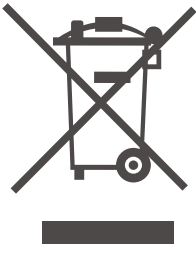

EU Manufacturer of Record:
Horizon Hobby, LLC2904 Research RoadChampaign, IL 61822 USA
EU Importer of Record:
Horizon Hobby, GmbHHanskampring 922885 Barsbüttel Germany
Australia/New Zealand:
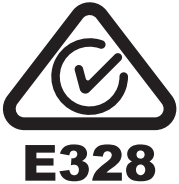

22 DRACO 2.0m
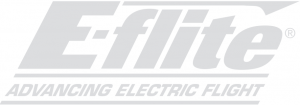

©2021 Horizon Hobby, LLC.
E-flite, Avian, Plug-N-Play, Bind-N-Fly, BNF, the BNF logo, DSM, DSM2, DSMX, Spektrum AirWare, IC3, IC5, AS3X, SAFE, the SAFE logo, the Smart Technology logo, ModelMatch, and the Horizon Hobby logo are trademarks or registered trademarks of Horizon Hobby, LLC.The Spektrum trademark is used with permission of Bachmann Industries, Inc.The DRACO name and likeness is property of Mike Patey and is used under license.All other trademarks, service marks and logos are property of their respective owners. US 8,672,726. US 9,056,667. US 9,753,457. US 10,078,329. US 9,930,567. US 10,419,970 .US 10,849,013.Other patents pending.http://www.horizonhobby.com/
www.horizonhobby.cc/MikePateyWebSitewww.horizonhobby.cc/MikePateyYouTubewww.horizonhobby.cc/MikePateyFacebookwww.horizonhobby.cc/MikePateyInstagram
EFL12550, EFL12575 Created 02/21 60070.1
References
registermyuas.faa.gov/
Product Serivce Center
Spektrum RC Transmitters and RC Electronics | Spektrum
RC Airplanes and Helicopters, RC Cars and Trucks, RC Boats, RC Radios | Horizon Hobby
Mike Patey – Official
Mike Patey | Facebook
RC Cars, RC Trucks, RC Airplanes, Model Trains, and Slot Cars at Tower Hobbies
Mike Patey – YouTube
RC Airplanes and Helicopters, RC Cars and Trucks, RC Boats, RC Radios | Horizon Hobby
RC Airplanes and Helicopters, RC Cars and Trucks, RC Boats, RC Radios | Horizon Hobby
RC Airplanes & Helicopters, RC Cars & Trucks, RC Boats, RC Radios | Horizon Hobby
Home – Know Before You Fly
RC Airplanes and Helicopters, RC Cars and Trucks, RC Boats, RC Radios | Horizon Hobby
[xyz-ips snippet=”download-snippet”]


